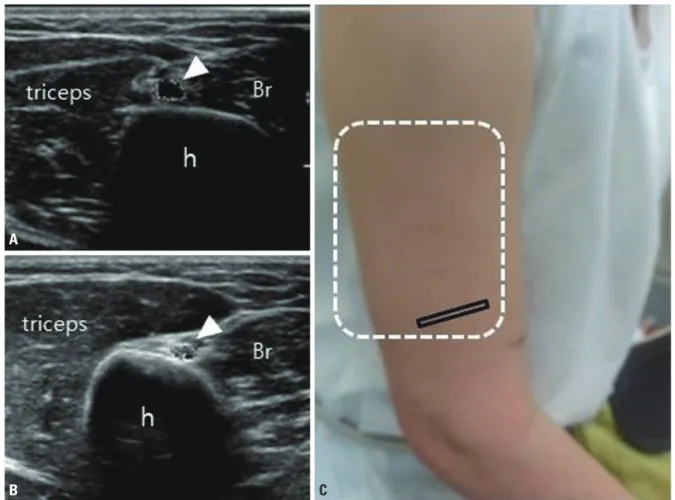Received: November 16, 2019 Revised: February 10, 2020 Accepted: February 11, 2020 CliniCAl
neurophysiology
Correspondence to Jung Im Seok
Department of Neurology, Catholic University of Daegu School of Medicine, 33 Duryugongwon-ro 17-gil, Nam-gu, Daegu 42472, Korea
Tel: +82-53-650-3440 Fax: +82-53-654-9786 E-mail: ji-helpgod@hanmail.net
Ultrasonographic evaluation of com- mon compression neuropathies in the upper limb
Jung Im Seok
Department of Neurology, Catholic University of Daegu School of Medicine, Daegu, Korea
Neuromuscular ultrasonography has emerged over the last decade as a useful tool for diag- nosing peripheral nerve disorders. It has been studied extensively with a particular focus on the assessment of compression neuropathies. Neuromuscular ultrasonography complements electrodiagnostic studies well by visualizing both the nerve anatomy and surrounding struc- tures, providing useful data that cannot be obtained using the latter methodology only. This review article summarizes and synthesizes the literature focusing on the diagnostic role of neuromuscular ultrasonography in common compression neuropathies of the upper limb.
Key words: Nerve compression syndromes; Ultrasonography; Upper extremity
INTRODUCTION
Compression neuropathy is a common disorder of peripheral nerves caused by mechan- ical compression whose clinical manifestations include pain, paresthesia, numbness, and muscle weakness resulting from a loss of function (motor and/or sensory) of the affected nerve. The term entrapment neuropathy is sometimes used interchangeably with com- pression neuropathy, but it describes only a subset of compression neuropathies resulting from chronic compression between the ligamentous canal and adjacent bony surfaces.
Compression neuropathies of the upper limb are common in the general population, including carpal tunnel syndrome (CTS), ulnar neuropathy at the elbow (UNE), and radial neuropathy at the spiral groove (SG).
Compression neuropathy is often diagnosed clinically and confirmed by electrodiag- nosis (EDX). Although this method is the first line of diagnosis, it has two key limitations:
the inability to provide anatomic data and discomfort for the patient. In contrast, neuro- muscular ultrasonography is painless, and it also complements EDX well by being able to detect a structural cause of the compression and focal nerve swelling.
ORCID Jung Im Seok
https://orcid.org/0000-0001-9219-9093
COmmON sONOgRaphIC fINDINgs assOCIaTeD wITh COmpRessION NeU- ROpaThy
Abnormal sonographic findings associated with compres- sion neuropathy include enlargement of the nerve proximal to the site of compression, decreased echogenicity, and increased vascularity. Increased nerve cross-sectional area (CSA) has been the most reliable parameter for diagnosing compression neuropathy, mainly due to it providing quan- titative and easily measurable data. We have previously published normal reference values for CSA in the Korean population (Table 1), as well as cutoff values for diagnosing neuropathy of 12.7 mm
2for the median nerve at the carpal tunnel and 8.9 mm
2for the ulnar nerve at the medial epi- condyle.
1A new sonographic parameter for diagnosing compressive neuropathy is the ultrasonographic Tinel sign.
2In a physical examination, a positive Tinel sign is when the palpation of injured nerves causes a tingling sensation, and is commonly observed in patients with CTS. The ultrasonographic Tinel sign produces paresthesias when the ultrasound probe compresses an enlarged focal nerve lesion, which can be helpful in diagnosing compressive neuropathy.
meDIaN NeUROpaThy aT The wRIsT
Diagnosis
CTS is the most common type of nerve compression en- countered in clinical practice, and EDX has traditionally been used as the gold standard for diagnosing this syndrome.
Table 1. Normal reference values for CSA
1Nerve Site Mean ± SD Percentiles (2.5th, 97.5th) Reference range
aMedian Carpal tunnel 9.58 ± 1.55 7.02, 12.58 6.48-12.68
Median Forearm 6.87 ± 1.61 4.91, 10.19 4.91-10.09
Ulnar Wrist 4.72 ± 0.91 3.21, 6.10 2.90-6.54
Ulnar Medial epicondyle 6.64 ± 1.33 4.81, 8.89 4.81-8.89
Radial Spiral groove 6.48 ± 1.68 4.22, 9.97 4.22-9.97
All values are in mm
2.
CSA, cross-sectional area; SD, standard deviation.
a


